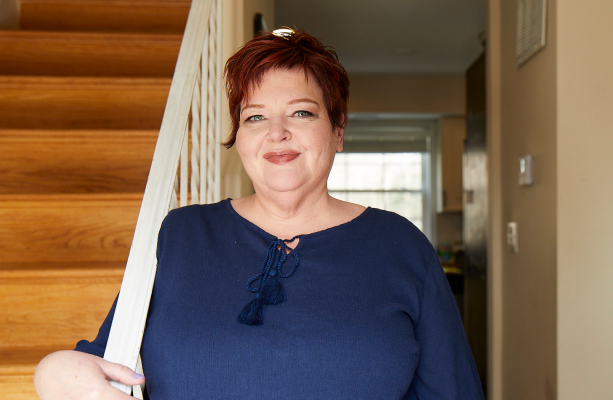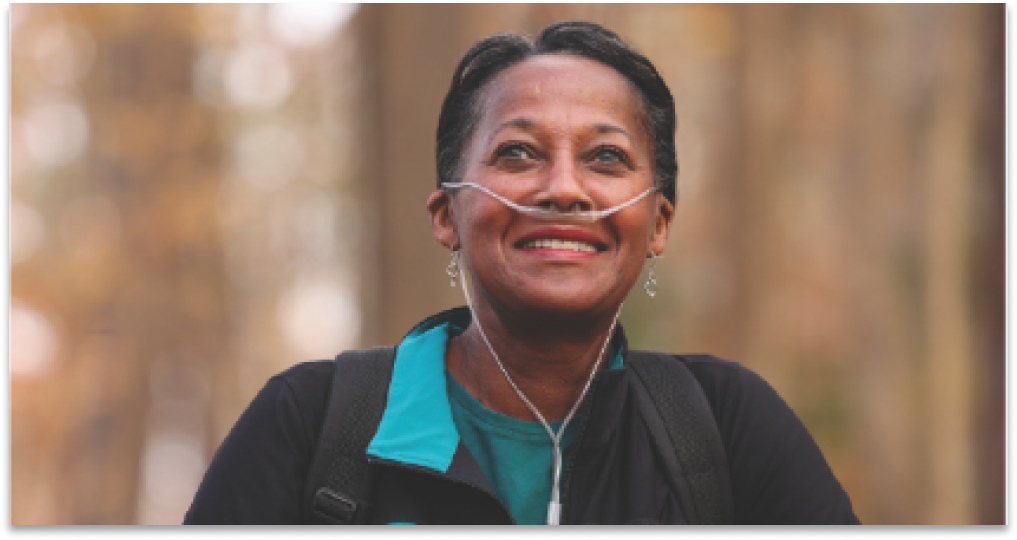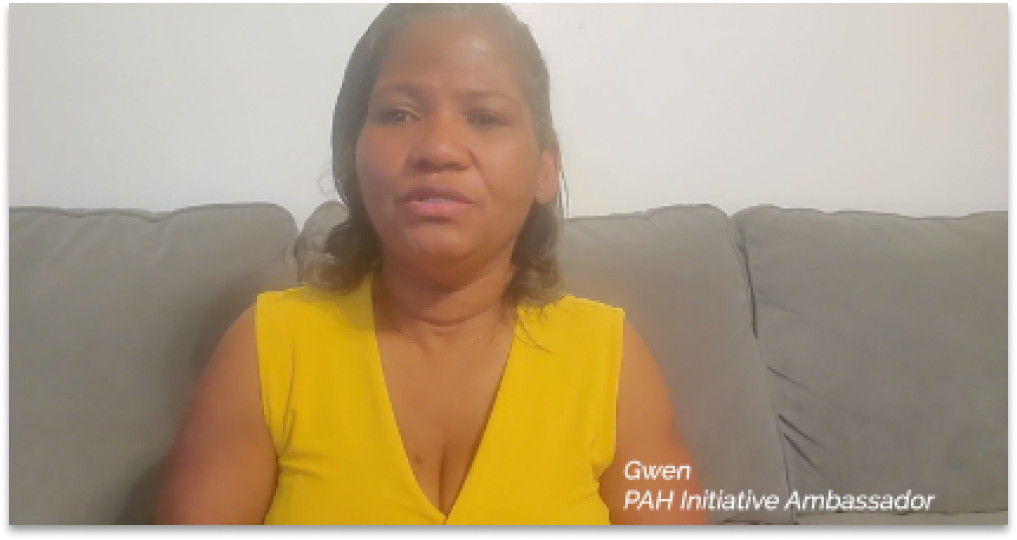
Sometimes Karen feels as if her life is built around food. What to eat, how much to eat, what to avoid, and how to plan for unexpected circumstances. This wasn’t always the case, but when Karen was diagnosed with pulmonary arterial hypertension (PAH) in 2013, she had to make some changes for her health. Karen has learned a lot over the years, making her a more creative cook and an even better mentor and friend to others living with PAH.
Karen has a fairly routine morning. She often eats a hard-boiled egg and a piece of Hawaiian bread with her medicine. When she gets bored of that, she might have a yogurt and banana or a teaspoon of peanut butter and jelly. She’s careful to take her medication with food and explained, that for her, “I need a little fat and a little carbs to ease digestion.”
“The key is figuring out what works for you,” she said as she talked about the foods she no longer eats. With PAH, many people avoid high-sodium foods and carefully read labels.
Sodium can be found where you least expect it. “I had no idea there were 120 grams of sodium in a glass of milk!” Karen said.
Karen has given up on big chain restaurants that make it hard to cut down on her sodium intake. Her tastebuds are trained so well now that she says even a bite of pasta at a chain restaurant will turn her away. She prefers to dine at mom-and-pop establishments and local places that will modify food or deconstruct meals so that she can better control her sodium intake. “I hate to have to play “food roulette,” as I call it.” she stated. “But sometimes you learn the hard way.”
Now Karen knows her body well enough to know what to eat—and what to avoid.
When she joins a friend for breakfast, she avoids sausage and bacon. She recalled the last time she had bacon and remembered all too well how it made her feel. Now she avoids processed meats completely.
If Karen is planning a dinner out with friends, she makes careful choices all day, reserving her daily intake of sodium for the evening. “I eat before I go out,” she said, “That way I am not starving and eating all the bread and butter before the meal even comes.”
Karen monitors and cuts back because one sodium-filled meal will be enough to ruin a perfectly good day. The Vietnamese soup, pho, is a high-sodium no-go for Karen, but that doesn’t mean she can’t have other Asian food delights. She loves dumplings but opts out of the dipping sauce. Even light soy sauce carries too much sodium for Karen. Instead, she asks for a side of plain white vinegar and flavors it with wasabi. With just a touch of dumpling sauce added in, she has a flavorful low-sodium alternative.
“I don’t care if anyone thinks my sauce is unusual,” Karen said. “At least I can still enjoy the dumplings.”
Portion control is another way Karen tackles ever-mounting sodium in many tasty treats. If she ever finds herself sitting down for Mexican food, she mentally counts the sodium in the typical culprits: chips, refried beans, and everything in between! In these cases, Karen cuts the portion to decrease the sodium. It may be hard to pay for a full meal and eat half the portion, but Karen knows better than to pay with her health. She reminds herself often that no meal is worth that.
At home, Karen finds that having to watch her sodium intake has made her a more innovative cook. She refuses to settle for bland food, so she looks for ways to squeeze every bit of flavor out without sacrificing her wellbeing.
“Marinating gives a deeper flavor,” Karen said. “I find that if I marinate chicken or fish for even 15 or 20 minutes, it will change the resulting flavor after it’s cooked.”
Sometimes she prepares it the day before, allowing it to marinate overnight. Karen has a favorite salt-substitute seasoning that makes her forget she ever enjoyed salt. “It comes in flavors like lemon pepper, fiesta lime, and even spicy jalapeno.” She’s been known to have a container of salt- substitute in her purse from time to time.
Carefully reading recipes helps Karen see where she can edit them to meet her needs. The first thing to go is always the salt. But even better, Karen likes to find PAH-friendly recipes that are low-sodium in the first place. Eating less processed food is one of her overall goals.
Now that Karen has the hang of it, she prepares her own homemade salsa, uses salt- substitutes, and chooses whole foods.
“Fast-food chains are fairly accommodating when it comes to unsalted french fries and all you have to do is ask,” Karen said. She has found that when making a request for unsalted fries, she often has to wait for a fresh batch, but then the result is worth it—hotter and fresher fries.
But she says she is careful with the dipping sauces because even ketchup has a lot of sodium. At home, Karen uses low-sodium ketchup.
Karen isn’t immune to cravings. Just because she makes healthy food choices most of the time, it doesn’t mean she never feels a longing for some of her old favorite comforts—like salt and vinegar chips or macaroni and cheese. She isn’t a fan of the repercussions that come with these foods but is certain that an all-or-nothing mindset doesn’t work for her.
Karen gets cravings out of her system by addressing them—not depriving herself. “I buy the one-dollar bag of chips and split it into three portions,” she said. “Then if I have a craving, I can eat 5–10 chips and solve it.” Sometimes a small bit of her favorite sodium-laden snacks will satisfy a craving, or better yet, Karen will prepare a healthier alternative.
At the end of the day, Karen likes to put her feet up. “Having experienced water retention in the past, I know the benefit of elevating my legs, plus there’s the added benefit of better circulation,” she said. Karen might watch TV, drink a cup of tea, and spend time with her dog while engaging in this self-care.
“Of course, there is a mental investment to thinking this hard about my food intake,” Karen said, reflecting on her lifestyle.
She knows she has put a lot of effort into living healthier. But at the end of the day, she knows that paying the price of reading labels and carefully selecting and preparing food is going to serve her best.
Today, Karen leads a support group to pay it forward, helping others on their journey with PAH and sharing her tips and tricks to living well and eating healthy.
PAH is a complicated disease that can be difficult to understand. We've broken it down for you with easy-to-understand information, simple graphics, and informative videos from a PAH specialist.
What is PAH?
Learn how Peggy renewed her competitive spirit after her PAH diagnosis and how she won't let an oxygen tank define her.
Competitive Spirit with PAH ⟩
How has knowing their risk status helped Lauren and Karen better understand if their treatment plan is working?
Knowing your PAH Risk Status ⟩
Living with PAH can be a big adjustment and taking care of yourself can make a big difference. But where do you start?
Self-Care and Healthy Living ⟩